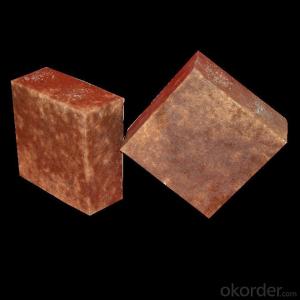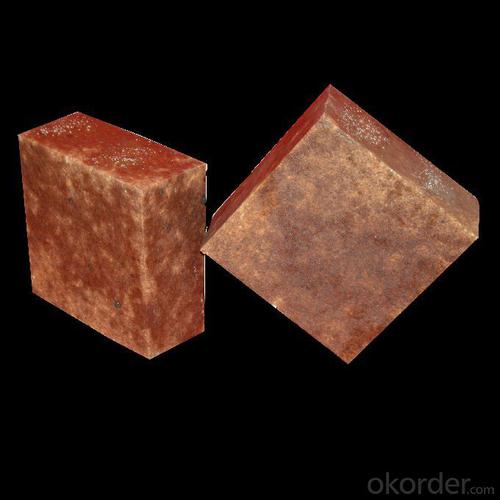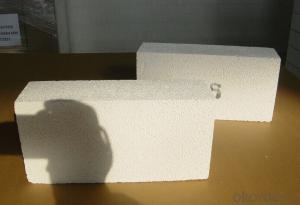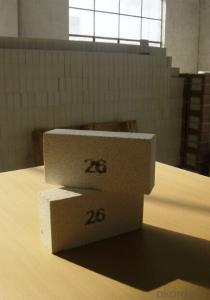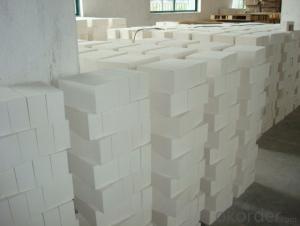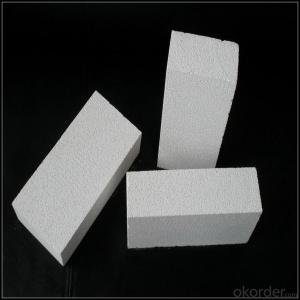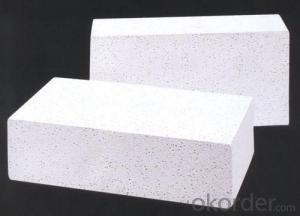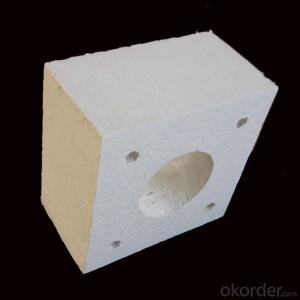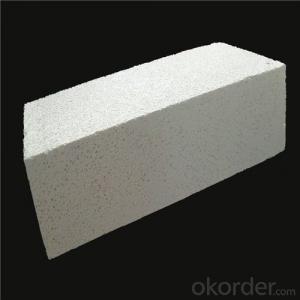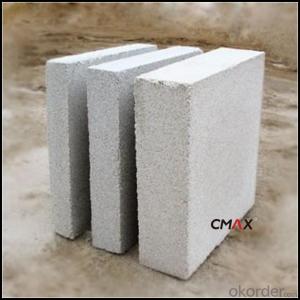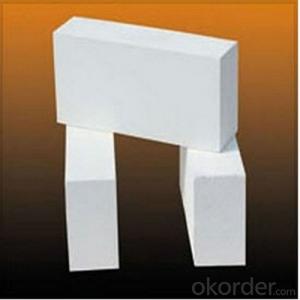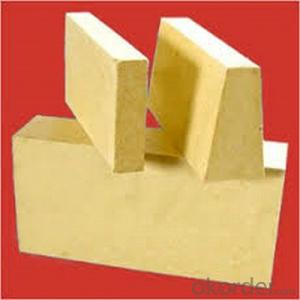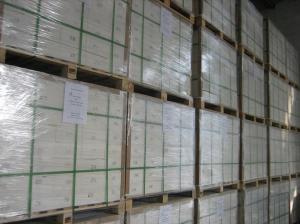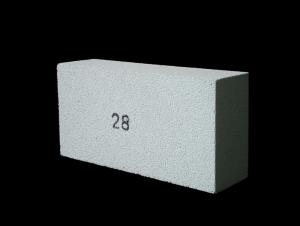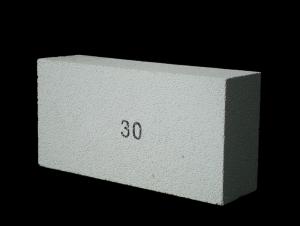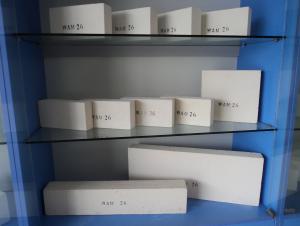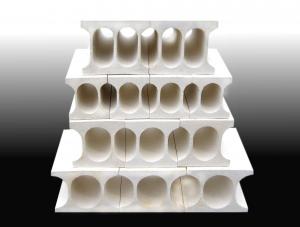Insulating Fire Brick for Ladle High Temperature Refractory Brick
- Loading Port:
- Shanghai
- Payment Terms:
- TT OR LC
- Min Order Qty:
- 10 m.t.
- Supply Capability:
- 100 m.t./month
OKorder Service Pledge
OKorder Financial Service
You Might Also Like
Quick Details
| Place of Origin: | (Mainland) | Shape: | Brick | Material: | Alumina Block |
| SiO2 Content (%): | 60-20% | Al2O3 Content (%): | 40-80% | MgO Content (%): | 0 |
| CaO Content (%): | 0 | Refractoriness (Degree): | 1770°< Refractoriness< 2000° | CrO Content (%): | 0 |
| SiC Content (%): | 0 | Model Number: | 69022000 | Brand Name: |
Packaging & Delivery
| Packaging Detail: | wooden pallet |
| Delivery Detail: | 30days |
Specifications
Refractory bricks for ladle, hot blast furnace
High alumina bricks
Fireclay bricks
Insulating bricks
Runner bricks
Our company located in yangquan city,Shanxi province, China, and Yanquan city is one of the
largest refractory material base in China. We are in position to supply various kinds of
refractory bricks, such as high alumina and fireclay bricks, insulating bricks etc
with the catalogue as follows:
1. fireclay brick
2. high alumina brick
3. insulating brick
4. unsintered phosphate brick
5. Al-C sliding plate
6. nozzle
7. hollowwares
8. refractory Mortar
9. refractory castables
10.other refractory material
If interested, pls do feel free to contact me.
Production can be arranged according to your specific requirements & drawings.
Looking forward to hearing from you the soonest.
FIRECLAY BRICK FOR GENERAL USE
Y-FB GFB40 GFB42 GFB45 |
Al2O3(%)min. 40 40 42 45 |
Fe2O3(%)max. 2.5 |
Refractoriness()min. 1710 1730 1750 1750 |
Refractoriness under load 0.2MPa()min. 1300 1350 1400 1400 |
Apparent porosity(%)max. 22 20 20 20 |
Cold crushing strength (MPa)min. 30 30 35 40 |
Linear change after reheating(%)max. At 1350×2h +0.1 -0.4 At 1400×3h +0.1 +0.1 +0.2 -0.5 -0.4 -0.2 |
Refractory Bricks
item | SK-32 | SK-34 | SK-36 | SK-37 | SK-38 |
Al2O3(%) | 38 | 42 | 50 | 65 | 70 |
Fe2O3 (%) | 3 | 2.5 | 2.5 | 2.4 | 2 |
Refractoriness (SK) | 32 (1710°C) | 34 (1750°C) | 36 (1790°C) | 37 (1825°C) | 38 (1850°C) |
Refractoriness under load, 0.2MPa, Ta, (°C) | 1300 | 1350 | 1450 | 1550 | 1580 |
Porosity (%) | 26 | 25 | 24 | 23 | 23 |
Bulk density (g/cm³) | 2.05 | 2.1-2.15 | 2.3-2.4 | 2.4 | 2.5 |
Cold crushing strength (MPa) | 25 | 25 | 45 | 45 | 51 |
- Q: Can insulating fire bricks be used for insulation in glass manufacturing?
- Insulation in glass manufacturing can be achieved using insulating fire bricks. These bricks are specifically designed to possess exceptional thermal insulation properties, a high resistance to heat, and low thermal conductivity. These qualities make them well-suited for situations where the maintenance or control of high temperatures is necessary, such as in glass manufacturing processes. The implementation of insulating fire bricks in glass manufacturing contributes to the reduction of heat loss and the enhancement of energy efficiency. By insulating the furnace or kiln, these bricks prevent excessive heat from escaping, resulting in a decreased energy requirement to sustain the desired temperature. This not only leads to savings in energy costs but also facilitates the establishment of a more stable and regulated environment for the glass manufacturing process. Moreover, insulating fire bricks possess the ability to endure the extreme temperatures typically encountered during glass manufacturing, thus making them a dependable choice for insulation. With a capacity to withstand temperatures reaching up to 3000 degrees Fahrenheit (1650 degrees Celsius), these bricks remain structurally intact and effective in their insulation function within the furnace or kiln. To summarize, the exceptional thermal insulation properties, high heat resistance, and low thermal conductivity of insulating fire bricks render them a suitable option for insulation in glass manufacturing. Their implementation aids in the enhancement of energy efficiency, the maintenance of stable temperatures, and the creation of a controlled environment for the glass manufacturing process.
- Q: Can insulating fire bricks be used in the construction of heat shields?
- Certainly, heat shields can indeed be constructed using insulating fire bricks. These bricks are specifically designed to withstand elevated temperatures and possess exceptional thermal insulation properties. Their ability to effectively absorb and distribute heat makes them an ideal choice for the creation of heat shields, which serve to safeguard against excessive heat and mitigate thermal damage. In industries that involve high temperatures, such as steel, glass, and ceramics, insulating fire bricks are frequently employed. Moreover, their lightweight nature and ease of handling make them a practical option for constructing portable or easily installable heat shields. In summary, insulating fire bricks are a reliable and appropriate material for constructing heat shields in a diverse range of applications.
- Q: How do insulating fire bricks help improve the efficiency of heating systems?
- Insulating fire bricks play a crucial role in improving the efficiency of heating systems by providing excellent thermal insulation. These bricks are specifically designed to have low thermal conductivity, which means they are able to minimize the transfer of heat from the heating system to the surroundings. By using insulating fire bricks, the heat generated by the heating system is effectively contained within the system itself, allowing for more efficient heating. This is particularly important in applications where energy conservation is a priority, as it helps to reduce heat loss and minimize energy wastage. Moreover, insulating fire bricks have high heat retention capabilities, which means they can store and radiate heat for extended periods of time. This characteristic enables the heating system to maintain a more consistent and stable temperature, resulting in improved comfort and reduced energy consumption. Additionally, insulating fire bricks also offer excellent resistance to thermal shock, meaning they can withstand rapid temperature changes without cracking or breaking. This durability ensures the longevity of the heating system and minimizes the need for frequent repairs or replacements, further enhancing its overall efficiency. In summary, insulating fire bricks contribute to the improvement of heating system efficiency by reducing heat loss, enhancing heat retention, and providing durability against thermal shock. By utilizing these bricks, heating systems can operate more effectively, consume less energy, and provide superior comfort.
- Q: Can insulating fire bricks be used in the construction of glass bottle production furnaces?
- Yes, insulating fire bricks can be used in the construction of glass bottle production furnaces. Insulating fire bricks have high thermal resistance and low thermal conductivity, making them ideal for use in furnaces where high temperatures need to be maintained. Additionally, they help to reduce heat loss, improve energy efficiency, and provide insulation against heat transfer, which is crucial in glass bottle production.
- Q: What is the bulk density of insulating bricks?
- Stoneware porcelain water absorption rate is greater than 0.5% and less than or equal to 3%; fine stoneware bibulous rate is greater than 3% and less than or equal to 6%; brick bibulous rate is greater than 6% and less than or equal to 10%; pottery tile water absorption rate is greater than 10%. The water absorption rate of expression: ceramic brick brick >6% = >10% = >3% = fine stoneware porcelain stoneware or porcelain >0.5%
- Q: Can insulating fire bricks be used for insulation in boilers?
- Yes, insulating fire bricks can be used for insulation in boilers. These bricks are designed to withstand high temperatures and are highly effective in retaining heat, making them suitable for insulating the walls and floors of boilers.
- Q: Can insulating fire bricks be cut to size?
- Indeed, it is possible to alter the dimensions of insulating fire bricks. Usually composed of lightweight refractory substances like expanded clay or vermiculite, insulating fire bricks are quite manageable to cut. Saws or knives are sufficient tools for this task. It is crucial to bear in mind that precautions should be taken while cutting insulating fire bricks to ensure safety. Wearing protective goggles and a dust mask is recommended due to the potential dust and small particles generated during the cutting process. Furthermore, it is advisable to either refer to the manufacturer's instructions or seek professional guidance to guarantee the correct technique and tools are employed for cutting insulating fire bricks.
- Q: How do insulating fire bricks affect the overall cost of a project?
- Insulating fire bricks can potentially increase the overall cost of a project due to their higher initial price compared to regular fire bricks. However, they can also lead to long-term cost savings by improving energy efficiency and reducing heat loss, resulting in lower energy consumption and operational expenses.
- Q: Do insulating fire bricks require a refractory mortar for installation?
- Yes, insulating fire bricks typically require a refractory mortar for proper installation. Insulating fire bricks are lightweight and have high insulating properties, making them ideal for applications where thermal efficiency is important. However, due to their lightweight nature, they can be more fragile and prone to cracking or breaking under stress. Using a refractory mortar specifically designed for high-temperature applications helps ensure a strong and durable bond between the bricks. Refractory mortars are formulated to withstand high temperatures and provide excellent adhesion and thermal expansion properties. This mortar helps to create a solid and secure structure by filling in gaps between the bricks and providing additional support. Without the use of refractory mortar, insulating fire bricks may not be properly secured and could shift or separate over time, compromising the integrity of the installation. Additionally, the absence of refractory mortar may result in reduced thermal efficiency due to increased heat loss through gaps and spaces between the bricks. Therefore, it is highly recommended to use a refractory mortar when installing insulating fire bricks to ensure a strong and long-lasting construction.
- Q: Do insulating fire bricks require any special insulation blankets or jackets?
- Insulating fire bricks (IFBs) are designed to have excellent insulating properties, so they generally do not require any special insulation blankets or jackets. However, depending on the specific application and environment, additional insulation may be needed. If the IFBs are exposed to high temperatures or extreme thermal conditions, it may be beneficial to use insulation blankets or jackets to further enhance their insulation capabilities and protect them from damage. These additional insulation materials can help reduce heat loss, increase energy efficiency, and extend the lifespan of the IFBs. Therefore, while not always necessary, it is worth considering using insulation blankets or jackets in certain situations to optimize the performance of insulating fire bricks.
Send your message to us
Insulating Fire Brick for Ladle High Temperature Refractory Brick
- Loading Port:
- Shanghai
- Payment Terms:
- TT OR LC
- Min Order Qty:
- 10 m.t.
- Supply Capability:
- 100 m.t./month
OKorder Service Pledge
OKorder Financial Service
Similar products
Hot products
Hot Searches
Related keywords
